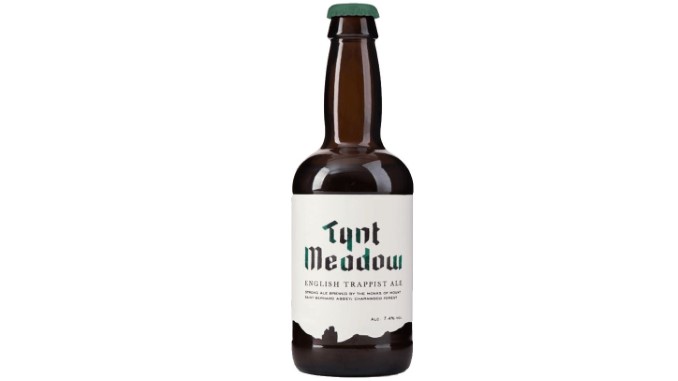Tynt Meadow English Trappist Ale
Photos via Tynt Meadow
We’re living in an interesting moment for classic Trappist beer—which is to say, beer brewed by Trappist Catholic monks in abbeys around the world. On one hand, the 2010s represented an era of new birth for the segment, as a handful of modern monasteries in countries such as Austria, the Netherlands, Italy, Spain and the United States began beer production for the first time, adding new Trappist names such as Tre Fontane and Zundert. But at the same time, one could also argue that consumption of Trappist beer, at least in the U.S., is more challenged now than it’s ever been, as appreciation for the styles and the hype they once possessed—the days of Westvleteren being the most sought-after beer in the world—has been massively dulled by the era of ubiquitous hazy IPA and pastry stout. You couldn’t ask for a more clear demonstration of this than the May 2022 closure of the Spencer Brewery at St. Joseph’s Abbey in Massachusetts, which first opened its doors in 2013. The only Trappist brewery in the U.S. had opened with great fanfare, and it made a product that pretty much all critics agreed was a high-quality offering … but it still wasn’t enough. In a setting where classic Belgian-style ales simply aren’t valued by many drinkers, it was simply too hard a sell.
And yet, the classic Trappist breweries persevere and presumably retain a big enough core of loyal drinkers, including the famed likes of Westvleteren, St. Bernardus, Rochefort, Chimay and Westmalle. As of today, there are 13 breweries producing Trappist beer in the world, although only 10 meet all the requirements to label their beer as Authentic Trappist Product, which means among other things that monks of their order are directly overseeing beer production. It remains a small niche, but an incredibly influential one.
And wouldn’t you know it, there’s another new Trappist player hitting the U.S. market these days, one we haven’t seen before. It’s not a new U.S. Trappist brewery, sadly, but it does hail from the English-speaking world. Mount St. Bernard Abbey is located almost dead-center in the middle of England, in the town of Coalville, Leicestershire, and it is home to the U.K.’s sole Trappist representative brand, Tynt Meadow. This is also the youngest Trappist brewery in the world today, having only been in production since 2018.
Mount St. Bernard Abbey produces just a sole brand, Tynt Meadow English Trappist Ale, which has recently begun hitting markets in the U.S. In terms of style, it’s sort of hard to know what to expect initially—does a Trappist brewery automatically brew Belgian beer styles be default? The description of Tynt Meadow makes it clear this is not the case—the English Trappist Ale is “a strong dark ale, but one with a clearly English character.” Importantly, it is brewed with English barley and hops, and fermented with an English yeast strain. So no, this 7.4% ABV ale is not in the style of a Belgian dubbel or anything like that, even if it does have part of the flavor profile in common.
So with all that said, let’s get to tasting.
On the nose, Tynt Meadow English Trappist Ale possesses a moderately assertive maltiness, suggesting toasted bread and dark fruit jam, along with dried fruit character suggestive of raisin and fig. There’s a hint of alcohol here, and maybe a touch of clove. There are hints of fruity esters, but notably the English yeast is not as expressive on the esters or phenols as you would get out of a classic Belgian abbey ale yeast—we’re left with a little bit cleaner presentation, albeit one that does have hints of fruity esters.
On the palate, Tynt Meadow revels in some strong malty flavors, with notes of black bread, prune, raisin, toast, and dark caramel or toffee. It has a mild to moderate residual sweetness, and really doesn’t read as overtly sweet at any point, but there’s enough to give vivaciousness to the fruity notes and lend a certain creaminess to the mouthfeel. Booze is present to a degree, though the ultimate impression is that this is a very drinkable 7.4% ABV, at least by abbey ale-type standards, with a finish that has a bit of drying astringency, amplifying the sense that this is not predominantly sweet. You could say the finished beer shares some elements with Belgian dubbel or a miniaturized quad, except for the fact that the yeast profile marks it as a British “strong ale,” not quite barleywine-like in stature or richness.
All in all, I actually quite like this, between its malt complexity and drinkability. Importantly, it possesses some spark of that mysterious, alluring quality of great Trappist ales. It seems to me that if there’s one thing Trappist beer needs to be above all else, it’s complex, and this can make that claim.
Tynt Meadow English Trappist Ale is sold in 330ml bottles, pictured above. If you’re a fan of the classic Trappist breweries, keep an eye out for it in your local market.
Brewery: Tynt Meadow (Mount St. Bernard Abbey)
City: Coalville, Leicestershire, England
Style: English strong ale
AVB: 7.4%
Availability: 330 ml bottles
Jim Vorel is a Paste staff writer and resident beer and liquor geek. You can follow him on Twitter for more drink writing.